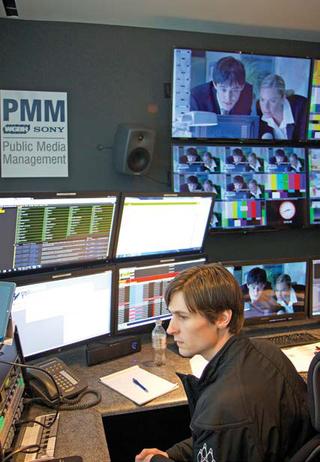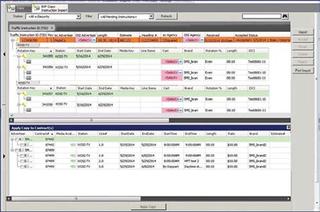No Longer ‘Business as Usual’
SAN FRANCISCO—Welcome new platforms, enter new headaches. While the content community has aggressively blazed new paths when it comes to disseminating content across multiple formats, one struggle has gone on mostly behind the scenes.
Business management systems—those intricately connected backroom systems that couple scheduling with ad sales and the like—have had to compensate for these new platforms and opportunities, while simultaneously reducing costs and increasing profitability along the way.
No small feat, but one that today’s solutions have begun to address in a number of ways.

Boston flagship PBS station WGBH recently installed a ProTrack Hub & Spoke system to work within WGBH’s larger PMM cloud-based service designed to centralize the acquisition and dissemination of content.SHARED AUTOMATED WORKFLOWS
It’s a model that’s proved its mettle time and again. That was one reason Myers has pushed forward with its ProTrack Hub & Spoke solution. Boston flagship PBS station WGBH recently installed a ProTrack Hub & Spoke system to work within WGBH’s larger PMM cloud-based service designed to centralize the acquisition and dissemination of content.
Using Myers ProTrack Hub & Spoke, media facilities are able to view and pull content into their facilities when it is required for playout. “The design of our ProTrack Hub and Spoke Solution was established to help our clients maximize operational efficiency,” said Crist Myers, CEO of the Northhampton, Mass.-based provider of media and business management systems. In addition to the WGBH installation, the system is up and running at Centralcast LLC in Syracuse, N.Y., a consortium of public TV stations in the state; and the Digital Convergence Alliance, a similar group in Jacksonville, Fla.
The infrastructure of the solution allows an individual station to capitalize on shared automated workflows while still maintaining their autonomy, Myers said, and is designed to help customers reduce operational costs and increase profitability.
The company is also in the midst of a growth spurt, adding staff and introducing new features within the ProTrack Broadcast Management System, a solution that manages acquisition, scheduling, monetization and distribution of content for multimedia facilities, according to Myers.
Get the TV Tech Newsletter
The professional video industry's #1 source for news, trends and product and tech information. Sign up below.
The company is also rolling out a new technology platform for the ProTrack Broadcast that will include new capabilities and workflows including a new HTML5 front-end.
SIMPLIFYING THE PROCESS
Sometimes the biggest difficulty is changing entrenched ideas. That was the challenge facing Imagine Communications.
Working in partnership with the media service provider Entertainment Communications Network (ECN), the Dallas-based company introduced a new feature within the LandmarkOSI traffic and billing system that can electronically receive and ingest commercial instructions using the SMPTE Broadcast eXchange Format (BXF) 3.0.
That small addition is working to change 40 years of advertising workflows, the company said.
“The new automated copy feature can yield significant efficiency gains for our LandmarkOSI traffic and billing customers, improving productivity, and reducing copy input mistakes and discrepancies,” said Sarah Foss, vice president of product management and advertising management systems for Imagine Communications.
The goal was to eliminate the longstanding process of manually typing copy instructions from e-mail or fax originals into a traffic system, she said. Commercial schedules can be ingested using XML to help eliminate the labor-intensive process of manually rekeying information, which helps reduce copy input mistakes and discrepancies.
At its simplest, the integration between ECN’s service and the LandmarkOSI is designed to accelerate workflows between media placement and airtime. It will help to simplify commercial scheduling and reduce make-goods due to programming errors, the company said.
Other features within the newest version of Landmark OSI include programmatic API, which allows users to participate in proposals and sales with programmatic exchanges; an integrated Internet contract feature, which allows users to manage Internet advertising and linear TV advertising in a single system; and an analytics feature that integrates data from LandmarkOSI and other operational data to help improve forecasting, pricing and sales activities.
STREAMLINING SALES
SintecMedia, an Israeli-based provider of media business solutions, has an eye on the sales side of things and plans to introduce at the IBC Show, OnBoard, a TV sales-side platform designed to improve digital and programmatic advertising. OnBoard is an open API system that connects with both linear and digital platforms for either direct or programmatic buying and selling. The solution works to streamline the sales process by managing inventory offering, pricing and order confirmation, as well as providing post air analysis, according to Geoff Nagel, vice president of go-to-market strategy in North America.
From a single storefront, users can sell across any digital channel whether it’s programmatic or direct sales, Nagel said. “It’s evolutionary in that it doesn’t make you choose certain paths over any other,” he said. Stations can start simply and have a local sales team sell across linear and digital properties, or use OnBoard’s private marketplace functionality to sell premium inventory programmatically. “It’s that flexibility and evolutionary approach that’s working for customers,” he said. “We’re trying to help sellers reach more buyers.”
The company also is revealing advances in its core product OnAir, which coordinates departments and business teams using a common database; and IBMS, which has a new Promo Optimization feature that gives users more control over the promo process with a customizable promo placement engine. The company also recently introduced cloud versions of both systems.

Imagine Communications recently introduced a new feature within the LandmarkOSI traffic and billing system that can electronically receive and ingest commercial instructions using the SMPTE Broadcast eXchange Format (BXF) 3.0.THE PROMISE OF PROGRAMMATIC
One of the biggest trends in the market is the purchasing of advertising through programmatic means, which Google defines as “a technology-automated and data-driven method of buying and delivering ads against TV content.” Recent reports estimate that 4 percent of TV ads will be purchased through programmatic means in 2015, growing to 17 percent ($10 billion) by 2018.
That integration—with programmatic at the heart of it—is the future of business management, accoding to Brian Burdick, executive vice president of digital and programmatic for WideOrbit, a San Francisco-based provider of media automation and business systems technology. For stations that have not yet adopted a programmatic-type solution, there are risks to consider. “The risks are that they might lose out on revenue opportunities, and fall behind the knowledge curve of a practice that is [the industry’s] future,” he said. “For companies in broadcast, providing a converged solution for them to manage their programs—whether it’s broadcast or digital—is the way to move forward.”
That issue—one of integration—is a priority for WideOrbit. The company’s WO Programmatic TV system was developed to integrate with a user’s traffic system, whereby traffic, creative and credit information from WO Programmatic TV arrives with every offer. The system is integrated with the company’s WO Traffic, meaning that broadcasters can receive offers for spots directly within their traffic systems, and an order slides directly into existing approval and billing workflows.
The system follows a typical process of buyers placing orders for spots, followed by stations seeing a price, an advertiser and the creative spot. A so-called “heat map” can tell a buyer whether the price is higher than they usually get for the spot in question, and then a station can accept or reject the offer by analyzing the information that comes along with the sale—such as comparisons to current rates, community standards or potential conflict with other sales channels.
The system is also attractive to ad buyers, Burdick said, because the company’s installed base has access to a large footprint of local broadcasters. At its heart, the system makes it easier to buy spot and local TV by automating processes, as well as allowing advertisers and agencies to bring their own data and customer analytics to identify valuable audiences.
TAKING THE PULSE
Along with programmatic solutions, the demand for improved workflows is a market-wide priority. But with so much bantering around of this “w” word, what does workflow actually mean?
“The term means so many different things to each and every facility,” said Greg Dolan, COO of Xytech Systems, a Mission Hills, Calif.-based provider of facility management software tools. “From media manufacturing decisions, budget milestones, signal path creation, rostering, equipment rental, asset management, and on and on, the workflows just pile up. Each one is crucial and each one must be managed and tracked in a configurable, transparent manner.”
That’s a component of the company’s Media Pulse solution, which has the ability to tie all of these workflows across the entire spectrum into a cohesive system, he said.
The newest version of the platform-agnostic Media Pulse addresses production, broadcasting, media services and transmission. For broadcasters, the system addresses scheduling, resource management and content management, allowing elements within the video transmission chain to be managed. On the production side, the system can manage financial information, personnel, technical resources and media assets.
Likewise, managing and scheduling media assets is the primary goal of the Louise business management system from Pro-consultant Informatique, a French-based provider of media business management software. Working in conjunction with traffic, sales and billing solutions, Louise can manage assets across linear and nonlinear platforms.
Susan Ashworth is the former editor of TV Technology. In addition to her work covering the broadcast television industry, she has served as editor of two housing finance magazines and written about topics as varied as education, radio, chess, music and sports. Outside of her life as a writer, she recently served as president of a local nonprofit organization supporting girls in baseball.
